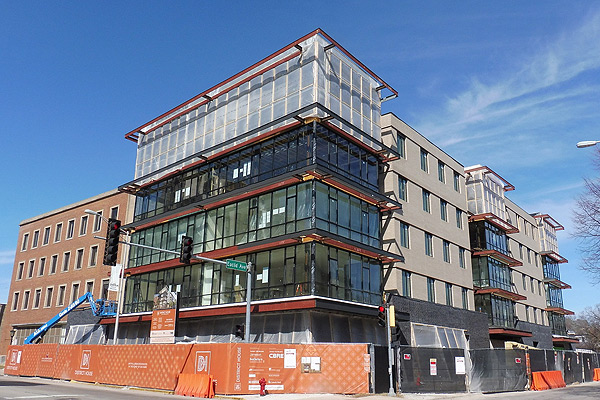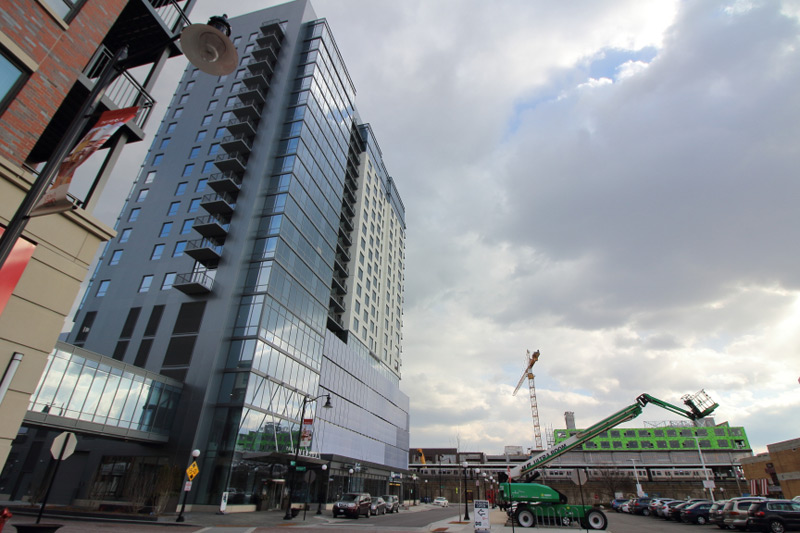Chicago’s downtown core and trendy neighborhoods along the Blue Line aren’t the only areas seeing big bumps in dense new development. In recent years, the edge suburbs of Oak Park and Evanston have witnessed the construction of several new high-rises that have delivered hundreds of new rental units near busy transit hubs, helping to fill a void by offering newer upscale housing with amenities more typically found in downtown tower construction.
In late 2016, Oak Park’s modest city center welcomed its tallest building yet: the 21-story, 270-unit Vantage Oak Park rental tower. Then last autumn, the 20-story Emerson delivered another 271 apartments, a parking garage with room for over 400 vehicles, and a new Target store just steps away from the Harlem/Lake Green Line station. But there’s still more on the way.
Construction continues on a seven-story mixed-use development just across the street from the Harlem/Lake station. The upcoming project is slated to yield 263 rental units, roughly 15,000 square feet of ground-level retail, and parking for another 400 vehicles by early 2018, according to Irini Boeder, Assistant VP of Marketing for developer Lincoln Property Company.
Meanwhile in Evanston, developers are finding that as proposals grow in height and density, the more difficult it is to generate the political willpower needed for approval. For instance, while a proposal for a 15-story, 273-unit transit-oriented development for 1450 Sherman Avenue was approved by the city late last year, two other plans—a 33-story apartment tower at 601 Davis Street and a 37-story mixed-use tower for Sherman Avenue—were blocked by Evanston’s Planning and Development Committee in recent weeks.

This does not mean that demand for new luxury rentals and retail space in these two edge cities in waning, says Kage Brown of Hubbard Street Group, a developer that has worked on several new mid-rise tower projects in both Chicago and Evanston in recent months, including the 12-story Centrum Evanston.
“Evanston is a big city but at the end of the day, there is pressure against some of these projects,” Brown says. “We went through the zoning approvals with a 12-story building, but when you start getting into 20 and 30 stories, it really deviates from the core of what Evanston is.”
This is a theme that Boeder also touches on, adding that Lincoln Property Company worked diligently with the village of Oak Park and the Oak Park Economic Development Corporation (OPEDC) to make their project possible.
“We worked to build something that fits into the neighborhood and that is complementary to Oak Park,” Boeder says. “Our team was in constant communication with the village and the OPEDC to ensure that we were in line with the goals of Oak Park.”
Brown says that there are parallels to developing in Evanston and Oak Park and communities along the Milwaukee Avenue corridor where there is increasing concern towards the influx of taller, denser tower proposals and how they can quickly impact the character and cost of living of a neighborhood. However, Brown adds that two major reasons why these taller proposals for Oak Park and Evanston continue to surface is that there’s still strong demand for luxury housing and interest from financial institutions to back these developments.
“Evanston and Oak Park are almost like offshoots of the city where the renter pool is growing and you still have good transportation to downtown Chicago,” Brown says. “Rent growth in the suburbs is driving the demand and possibility for these dense projects.”



